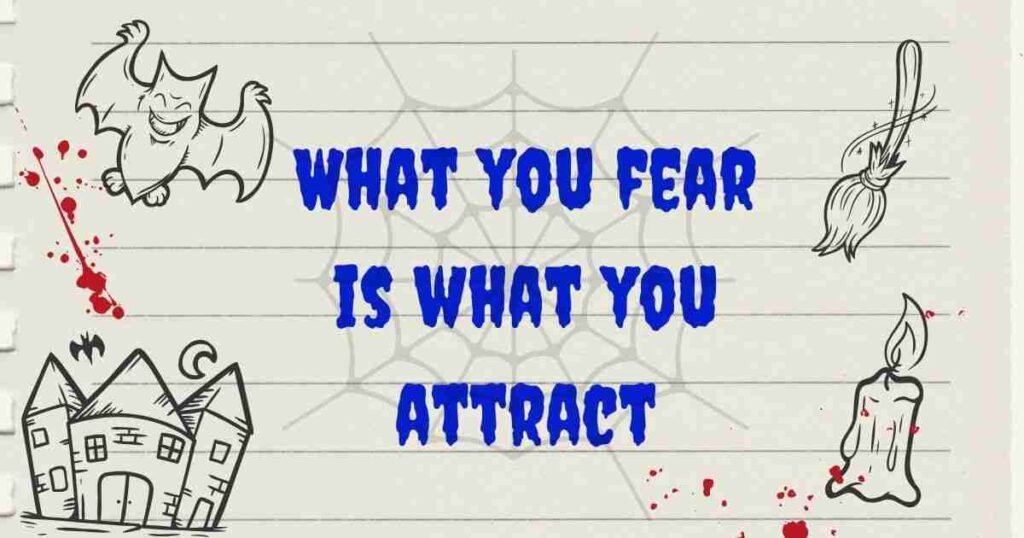What you fear is what you attract has fascinated and perplexed many.
Our thoughts, vibrating at a certain frequency, draw towards us the very things we try to avoid.
This concept is often linked to the law of attraction and proposes a strong connection between our deepest fears and the reality we experience.
How reliable is this statement? How does fear shape our lives, and can we truly attract what we fear?
This article offers insights into the intriguing psychological landscape of fear and how we can harness this knowledge for positive change.
Key Takeaways
- Fear influences reality through a connection between thoughts and experiences.
- The fight-or-flight response narrows focus, making us alert to resonating concerns.
- Negative thoughts can become self-fulfilling prophecies, shaping behavior.
- Confirmation bias reinforces anxieties by favoring information confirming preconceived notions.
- Subconscious fears from past traumas impact choices and behaviors.
- Strategies include intentional manifestation, cognitive restructuring, and exposure therapy.
- Expressing gratitude and trust attracts positive vibes for desired outcomes.
What You Fear is What You Attract: A Close Inspection

What you fear is what you attract merely a coincidence in our daily lives? Does what we dread always catch up with us?
But below the surface, it shows a complex web of mind tricks.
Let’s explore the psychological foundations of fear and attraction.
1. Decoding the Fight-or-Flight Response:
Our brains are set up to stay safe with a basic alarm system called “fight-or-flight.” This mechanism is deeply rooted in our evolutionary history, acting as a crucial guardian in times of danger.

When dealing with a physical or emotional threat, our bodies undergo a remarkable shift.
The powerful hormone adrenaline floods our system. This sudden rush is nature’s way of preparing us for immediate action.
But this alertness can backfire. It makes us focus only on what scares us.
Imagine observing the world in a state of fear.
Suddenly, shadows turn into fright, and you only think about what to do right now. Our focus narrows to immediate reactions.
Anxiety makes us more alert to things that match our concerns, making them more likely to happen.
Neuroscience explains it through brain pathways and fear responses.
Your brain can only shine on one thing at a time.
The reticular activating system (RAS) in our brain filters information that matches your dominant thoughts.
If fear takes over, your RAS spotlights anything related to it, making the feared outcome seem everywhere.
Fear and neuroplasticity work together, strengthening negative thought patterns.
We don’t just passively observe our world—we actively construct it through our perceptions, interpretations, and reactions.
Understanding the response is critical to managing it without panic taking over.
2. The Self-Fulfilling Prophecy: Manifesting Reality
Our brain has ways of making us attract what we fear.
This is because our mind constantly scans for threats, even when they aren’t real.
The amygdala and limbic system are wired for survival, but in today’s world, this can make us overreact.
This heightened alertness makes us see danger when there is none.
Fear not only affects how we perceive things, but it can mold our reality.
Negative thoughts cause self-fulfilling prophecies, altering behavior and communication.
Self-fulfilling prophecies suggest that our positive or negative expectations can significantly impact our experiences.
When we constantly worry about rejection or failing, our actions unknowingly enhance those fears.
Unintentionally, we make our apprehensions real. You attract what you fear.
As Ralph Waldo Emerson aptly stated,
“Do your worst, and it shall never reach you. Fear it, and you invite it.”
Imagine someone who is constantly afraid of speaking in public. Apprehension is evident through shaky hands, a stammering voice, and withdrawn behavior. It bolsters insecurity and the initial fear.
Similarly, unease about society might appear as withdrawn body language or hesitant communication.
These cues can push people away, confirming the belief that we are unlikable or undeserving of friendship and contribute to social isolation.
Students who expected to do poorly on a test scored much lower than those with positive expectations. It depicts the impact of mindset on tangible results.
Positive feedback fades into the background, while negative signals are amplified.
Every tick and misstep add to our perceived failure, intensifying our initial worries.
3. Beyond the Surface: Confirmation Bias and Selective Attention

Confirmation bias and selective attention operate not only on the surface but also internally to control our thought processes.
Our minds are not impartial observers; they filter information through the lens of our beliefs and anticipations. This tendency is known as confirmation bias. It forms our behavior, interactions, and decision-making.
It’s a psychological phenomenon where individuals favor information confirming their preconceived notions or hypotheses. It often overlooks or undervalues evidence that contradicts their views.
In social media, this bias makes us prefer content that agrees with us, forming echo chambers that fortify our values and block out diverse opinions.
In decision-making, confirmation bias can cause poor judgments by disregarding conflicting information.
When we fixate on a specific worry, like fear of failure or rejection, we tend to pay more attention to information that backs up that concern. We ignore contradictory information.
This selective attention can create a distorted view of life.
Certain aspects are emphasized, while others are neglected. It can have profound effects on mental health, relationships, and personal growth.
Consider someone afraid of failing and rejection. When they encounter a problem, they often pay too much attention to their past errors or criticism.
They need to recognize their successes and chances to get better.
This narrow way of seeing things can ramp up stress levels, creating a feedback loop of negativity.
They may seem distant, avoiding social interactions and pursuing a cycle of isolation.
This behavior makes it seem like a never-ending series of blunders, further entrenching the terror of flopping and dismissal.
Develop an awareness of these cognitive biases and actively work to counter them to be free from this cycle.
4. The Subconscious Dialogue: Deciphering hidden Whispers
The dynamic between fear and attraction surpasses conscious thought.
Deep in our minds, in the subconscious, a vast collection of memories and experiences remains hidden.

This hidden trove carves our lives, often without us even realizing it.
Unconscious fears from past traumas can strongly influence our choices and behaviors. They have a magnetic pull, attracting situations that resonate with these anxieties.
Fear is not merely a sentiment; it’s a force that can determine our life’s trajectory.
It often dictates our decisions and actions and colors our reactions to the ecosystem.
They operate like invisible puppet strings, subtly guiding our journey through life.
People haunted by childhood abandonment often seek out emotionally distant partners, repeating the same rejection series.
They end up feeling undeserving of true love.
Such patterns illustrate how subconscious doubts impact our relationships and self-esteem.
You attract what you fear.
You start to feel like a burden.
The law of attraction connects energy, thoughts and results.
Doubt and desire go hand in hand.
But we are not weak.
We are not destined to be controlled by our unconscious fears.
We can transcend this repetitive rhythm within our reach.
How to Stop Attracting What You Fear: Manifesting Your Desires

Have you ever craved a life filled with boundless opportunities, where fears vanish like morning mist, and your deepest desires come true in exciting ways?
This is the heart of intentional creation: making your dreams into real experiences and changing your outlook.
It’s about stepping away from the uneasiness and stepping into your real potential.
It’s about shining brightly and liberating yourself from drawing in what you dread.

Planting the Seeds of Intention:
Express your aspirations with unwavering precision. Vagueness confuses, while clarity leads to success.
Forging your dreams into reality begins with a seed: a vivid vision of what you truly want.
Set your intentions with exactness and foster your vision with positivity.
Welcome to a supportive environment. Exercise patience and determination.
Imagine achievement and take inspired action.
Stay open to unexpected possibilities, and maintain unwavering focus.
Picture a gardener tossing seeds in the wind – uncertain where they’ll grow. But instead, a skilled cultivator, caring for each seed and foreseeing beautiful blooms.
This is the energy of intention – not a passive wish, but a potent fertilizer for your wishes.
As you nurture your goals with determination and precision, the universe responds by bringing alignment and changes into your life.
People also read:
I can’t be alone with my thoughts: Overcoming challenges and finding comfort
Don’t let anyone disturb your peace
Cognitive Restructuring:

Challenging negative biases and nurturing empowering thoughts can be a turning point.
Test assumptions underlying your fears, distinguishing between facts and assumptions.
Journaling aids in identifying recurring negative thought patterns and exploring healthier alternatives.
Educating yourself about cognitive biases helps you to address negative thought patterns.
We can choose a call to action for a mental shift, self-growth, and transformation.
Exposure Therapy:
This method slowly introduces someone to their fear in a secure and orderly setting.

People learn to deal with their worries and find ways to handle their feelings to build resilience.
The process begins with easy situations and slowly takes on harder ones. In a case where a person is terrified of heights, they might start by just looking at photos of skyscrapers. Then, they might stand on a low balcony.
Finally, they could visit the top of a tall building. With each small step, they gently confront their fears, gradually gaining confidence. They use methods like breathing deeply, staying mindful, and encouraging themselves.
Repeated exposure weakens the fear response and improves their quality of life.
Reframing the Narrative

Reframing the narrative is about adjusting our ideas to create a more positive and encouraging story.
It also involves resisting the self-fulfilling prophecies we unconsciously construct.
We can develop an outlook of hope and the possibility to stop negative expectations from painting our reality.
Look for evidence that disagrees with our fears and question negative assumptions.
Cultivating a more balanced perspective can disrupt confirmation bias.
We all have the capacity to reframe our internal narrative and break free from the shackles of restricted thinking.
This doesn’t mean ignoring hurdles but being proactive. Gear up with the tools and resources necessary to navigate any obstacle.
Activating Your Visualization:
Once the seed is sown, visualization becomes your watering can. Enter your dream, feel success, achievement, and fulfilled dreams.
Engage your senses, breathe life into your aspirations, and shape your vibrant future.
This is the essence of visualization – it’s active, not daydreaming. Each detail adds energy.
Mindfulness Practices:

The role of the subconscious role in causing distress requires introspection and self-awareness.
Practices like mindfulness meditation and shadow work can illuminate these hidden patterns.
It allows us to address and heal past traumas. These techniques help to identify fear-based thoughts and redesign them.
We can foster better decision-making, improve relationships, and enhance our well-being.
Pattern Interruption Exercises
Learn to reset fear-based thought pattern. When fear kicks in:
- Notice when you feel afraid
- Interrupt the pattern with a simple action:
- Stand up and stretch
- Splash cold water on your face
- Say “STOP” out loud
- Take three deep breaths
- Snap a rubber band on your wrist
These quick interruptions snap you out of the fear loop, giving you a moment to think clearly instead of just reacting.
Choose a new response instead of falling into your usual worry habit.
Vision board Mastery:
Mostly, vision boards are a collection of imagery, words, and positive statements that convey your objectives.
By creating a visual representation of your intentions, vision boards help you stay committed to your pursuits.
They serve as a daily reminder of what you want, sparking motivation and clarity.
Whether it’s career success, personal growth, or any other goal, vision boards provide a creative and tangible means to connect with your ambitions.
You begin to grow in a positive direction.
Affirmations as Chisels:

Words hold strength, especially when woven into affirmations, your personal mantras for achievements.
Compose uplifting assertions, replacing self-doubt with steadfast confidence.
Repeat them like a daily song, sharing them with yourself in the quiet moments and chanting them with conviction in times of adversity.
Your affirmations are your chisel, erasing away negativity and sculpting the ideal version of yourself and your reality.
Action – The Bridge Between Dreams and Reality:
Manifestation thrives on the synergy of intention and effort, where big dreams come to life through consistent steps. Take your goals and make them attainable.
Celebrate when you hit the milestone, and keep going when things get complicated. An archer, aiming with focus and then releasing with accuracy.
Every step – setting the target, choosing the arrow, drawing the bow – matters to reach the mark.
Action is your bow, propelling your desires towards their intended destination.
Expressing Appreciation:
Gratitude is the culminating addition to your masterwork.
Acknowledge the blessings already present in your life.
If you dwell on what you lack attracts more of the same.
Attracting similar energies, you welcome the abundance. The universe conspires in your favor when you appreciate what you have.
Implementation Timeline
Letting go of manifesting fears takes time but can change your life.
With regular practice, you’ll start becoming aware of your fear-based thoughts within 1-2 weeks.
By 4-6 weeks, you may notice changes in how you react—pausing before responding, feeling less overwhelmed, or choosing calmer thoughts.
Over 3-6 months, these small shifts can lead to a major transformation, where old fear patterns no longer control you, and you naturally respond with more confidence and clarity.
Conclusion
Our exploration into the psychology of fear has revealed intriguing connections between our deepest fears and the reality we experience.
From the fight-or-flight response to self-fulfilling prophecies, confirmation bias, and subconscious influences, fear’s role in our lives is complex.
To harness this knowledge for positive change, we must cultivate awareness, challenge negative beliefs, and take intentional actions.
Visualization, mindfulness, and affirmations become tools to tailor our dreams into reality.
Action bridges the gap between aspirations and achievements, while gratitude and trust complete the journey.
Consistent practice of interrupting fear patterns can transform your entire experience of life.
What you fear is what you attract might not be a universal truth, the connection between our mental state and experiences is undeniable.
Ultimately, we can define the reality we desire by understanding and actively managing our jitters.
We invite you to share your experiences or thoughts on this topic. What strategies have you found effective in drawing more positive outcomes? Join the conversation and share your insights.
What You Fear is What You Attract Quotes
Here are a few insightful quotes:
“What you fear is what you attract.”
– Ralph Waldo Emerson
“Our thoughts attract what we fear.”
– Napoleon Hill
“What we fear we create.”
– Albert Einstein
“You attract what you fear because what you fear, you believe.”
– Rhonda Byrne
“The only thing we have to fear is fear itself.”
– Franklin D. Roosevelt
“Whatever we plant in our subconscious mind and nourish with repetition and emotion will one day become a reality.”
– Earl Nightingale
. “You attract what you are, not what you want. If you want great, then be great.”
– Zig Ziglar
“Fear is the prison of the heart. Face what you fear and it ceases to be.”
– James Hewitt
“You can’t stop the waves, but you can learn to surf.”
– Jon Kabat-Zinn
“Fear is a darkroom where negatives develop.”
– Usman B. Asif
“Everything you want is on the other side of fear.”
– Jack Canfield
“The cave you fear to enter holds the treasure you seek.”
– Joseph Campbell
FAQ
Additional Resources
Olivia Guy-Evans (2023). The psychology of fear: Definition, symptoms, traits, causes, treatment. Simply Psychology, Updated on July 20, 2023 (simplypsychology.org/what-is-fear.html)
LeDoux, J. (2012). Rethinking the emotional brain. Neuron, 73(4), 653-676.
“The Power of Now” by Eckhart Tolle